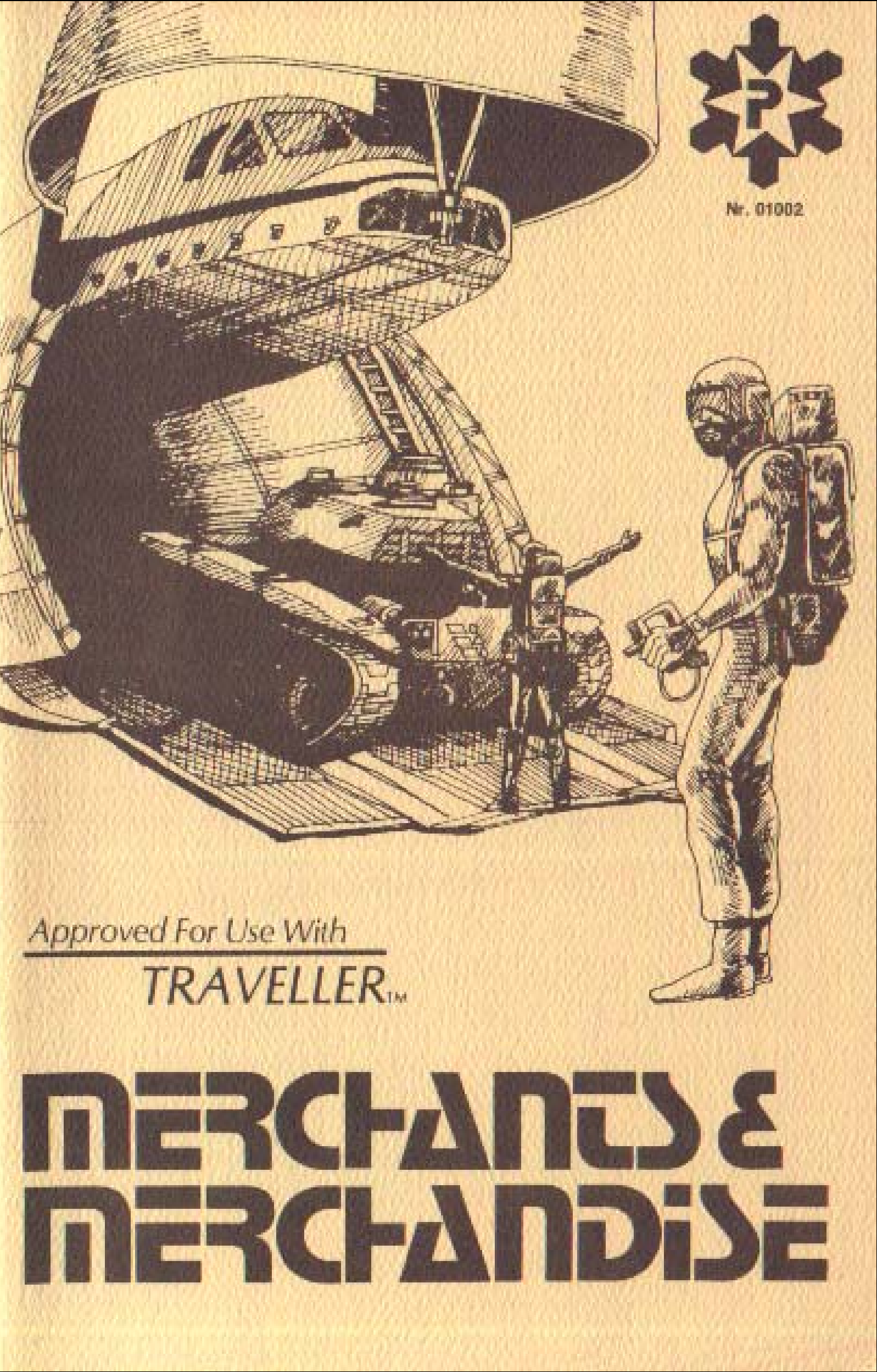This article originally appeared in the September/October 2023 issue.
 Merchants & Merchandise. Donald P. Rapp et
al.
Merchants & Merchandise. Donald P. Rapp et
al.
Paranoia Press (defunct, no website)
24pp. PDF (originally paperbound)
US$6.00/UK£4.70 (also on FarFuture Apocrypha 2 CD)
This volume from Paranoia Press was published in 1981, to provide for the Merchants an expanded character generation process similar to the expanded Army and Marines of Book 4: Mercenary and the Navy of Book 5: High Guard. It predates both Book 6: Scouts and Book 7: Merchant Prince; the latter was published in 1985, building on a Special Supplement from the original Journal of the Travellers’ Aid Society from 1982.
As is usual with expanded careers, having the basic Traveller books is necessary; some skills and procedures are defined in Mercenary, High Guard, or Paranoia Press’s other early career expansion, Scouts & Assassins, so having those should be considered necessary as well.
The author acknowledges inspiration from the United States Merchant Marine, and the expanded career presented does have a somewhat military feel. The ‘backbone’ of trade in the Imperium is said to be handled by the ‘Imperial Merchant Service’, with ‘subsector merchant services’ and ‘tramps’ handling the rest. There is no discussion of megacorporations, or even any specific corporate involvement in trade; the occasional mention of ‘subsector merchant companies’ could just as easily be referring to pseudomilitary mercantile operations managed by a government as to a corporation or similar entity. The division of personnel into Officers and Enlisted is present, though ‘enlisted’ personnel are actually called ‘ratings’; there is one rank (Cadet) that is considered neither Officer nor Rating, but is treated as an Officer for most purposes. Beyond this, the rank structure is abbreviated in comparison with the GDW expanded careers.
Unlike the GDW expanded careers of Mercenary and High Guard, assignments within this expanded merchant career are not always one year at a time – some assignments are for two years, and a few are even for the full four years of a term. As written, the rules do not allow for an assignment to overlap the end of a term; I think allowing this might be an interesting variation on the ‘compulsory re-enlistment’ rule.
It should be noted that this is only an expanded career; unlike the later Merchant Prince, there are no alternative trade rules.
The expanded career generation starts by dividing the career into three ‘divisions’: Deck, which provides for general duty potentially leading to a Master’s Certificate and the ability to act as captain of a merchant ship; Engineering, specializing in maintaining and operating the physical plant of the ship; and Support, specializing in the comfort and safety of the crew and passengers. Once a character has selected a division, it is essentially impossible to transfer to a different division.
There are some concessions to the ‘civilian’ nature of trade; most assignments will resolve with ‘Bonus’ (a cash award based on rank/rate, though ships’ masters get an ‘official “Thank you”’ rather than cash) instead of ‘Decoration’ (although assignment to a military convoy is possible, and makes the character eligible in that assignment for the three standard decorations).
College is a pre-enlistment option, and is essentially lifted from High Guard, omitting the options for Medical School or Flight School. A character that attends College enters the Merchant Service as a Cadet, and whether the character has graduated with honors and taken NOTC determines which division (Deck, Engineering, Support) is entered. One may also apply directly to the Merchant Service Academy, but this is more difficult, and failing to gain direct admission has a negative impact on future promotions. Since ratings may be admitted to the Academy as a Special Duty assignment, without having to roll for (and risk failure of) admission, this might be a better route for entry.
The career is only half of the book, the “Merchants” in the title. The rest of the book is the “Merchandise”, a listing of items that may be encountered in trade. Names, prices, and a brief description of each item are given, including High Guard USPs for the two starships included, and range and weapons matrices for weapons included. The manufacturers of all items are placed in the Paranoia Press versions of Vanguard Reaches or Beyond sectors (neither of which had actually been published at the time of publication of this volume), and a few items seem technologically inconsistent with later GDW development of the Third Imperium setting.
A creative referee could profitably use this volume for creating merchant characters, or perhaps lift elements of this and of Merchant Prince and combine them. I consider the value as a separate DTRPG purchase marginal at the price, but it definitely contributes to the value of the FarFuture Apocrypha 2 CD.
 Freelance
Traveller
Freelance
Traveller